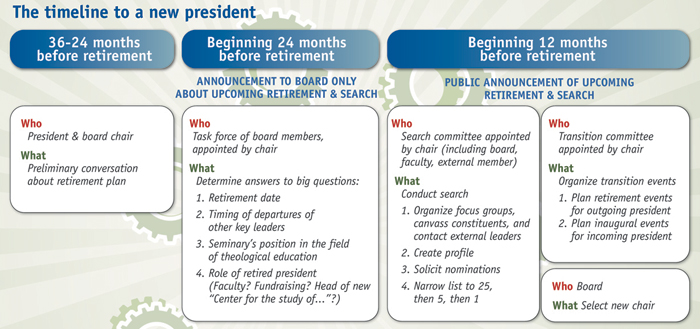
I had been chair of Fuller Theological Seminary’s board a few days when President Richard Mouw took me aside to talk about retirement. His, not mine. “You know, Dave,” he said, “it’s likely we’ll go through a presidential transition during one of your two terms.” Translated, that meant that Rich intended to step down within six years. It also meant that his retirement announcement, the design and implementation of a search process, the selection of the school’s fifth president, and the segue from one administration to the next would unfold on my watch.
I appreciated Rich’s heads-up, and also his suggestion about how we might work through the dozens of details that accompany a presidential transition. He proposed a collaborative relationship that initially would involve informal discussions between the two of us and eventually would engage our entire board. Once Rich, the board, and I had a date in mind, we would need to determine when to go public with the news, how to involve various constituencies in the search, how to balance confidentiality and transparency during the selection process, and how we would support the new president in the crucial early months of a new administration. We both knew that leadership changes are times of risk and opportunity for organizations. If we did this thing right, it would have a profound impact on the seminary. And if we got it wrong, the consequences would be just as profound.
Countdown to change
A couple of years before the likely retirement, with board input and approval, I put together a small task force of board members and asked them to tackle four questions. Their work would be confidential and would help us establish a timeline and a process. Their assignment was to learn:
-
What did the organization need to look like at the time of transition?
-
What was the current state of the seminary?
-
What were the wishes of our retiring president?
-
What role, if any, should the retired president have in the new organization?
The first question involved talking with Rich about the date he hoped to leave the presidency and how far in advance of that date we would announce his departure. Clearly, we wanted Rich’s input, but he understood that the board had to make these decisions based on what was best for
the seminary.
The second question was tougher to answer. For continuity, we wanted a provost in place for the final two years of Rich’s tenure and the first year or two of the new president’s term. The problem was that our current provost planned to retire before Rich. This meant we had to recruit a provost who was willing to lead us through the transition but who might not be the permanent choice of the new president. Whomever we put in that position had to have the maturity to accept the fact that this could be either a long-term or interim assignment. More complications: Several deans were within three or four years of retirement. Should the new deans be in place before the presidential transition, or should the new president participate in their selection?
The third question had two parts. Not only did we need to look at the state of Fuller Seminary, but also the state of seminaries in general. One of our board members prepared a document that summarized the challenges and opportunities ahead for theological education. It affirmed that the world was in the midst of change and that some degree programs were not as valued as they had once been. It reminded us that seminaries have to change, and that their presidents must have the skills to drive the required change. This document was vital as we discerned the kind of leader we needed to move Fuller forward.
The fourth question was easy and complex at the same time. The board felt it was in the seminary’s interest to retain Rich Mouw, given his tremendous gifts and reputation. Yet at the same time, the board was mindful of the complexity of having a much-loved former president stay at the institution. We knew that any role he assumed could not involve governance or faculty oversight. The solution we found was to ask the transition committee to work with Rich on a future role, to include an institute and a professorship of faith and public life. From this platform he could speak out on issues important to him and Fuller Seminary. It was a perfect fit.
One year out: Going public
The retirement announcement came in the form of a letter to the Fuller community signed by Rich. He explained that after much prayer, he had decided to retire on the 20th anniversary of his presidency. He would celebrate that milestone in one year. A week later, after the news had settled in, I sent a letter saying that although the trustees knew this was going to be a major transition, we had worked with Rich the last few years getting ready for this moment. The board appointed a 12-member search committee that included board members, faculty, and someone from outside the Fuller circle. These were not random selections. The faculty represented our three academic schools; the eight trustees brought executive management experience to the table; and the “outsider” was a former seminary president and current pastor with diverse contacts in the evangelical world.
An early goal of the search committee was to create a job profile, and for this we enlisted input from all our constituencies. We asked them what type of president they thought we should recruit. Later, we circled back to these same groups and said, “Here’s what you told us; here’s what we’ve learned; here’s the profile that has emerged. Please give us feedback.” And they did. Tons of it. We also pulled together eight focus groups, circulated a survey, and conducted dozens of interviews to flesh out the profile. As a final piece of research, we reached out to 134 leaders in the wider evangelical world. More than a hundred responded to these questions:
They reminded us that one of the paradoxes of success is this: The factors that contribute to an organization rising to the top may not be the same factors that keep it on top. In human resources terms: The kind of leader who guides an organization from Point A to Point B may not be the kind of leader to take the organization to Point C. Our new president would need the skills to address the present and future challenges of educating the next generation of church leaders.
These insights were invaluable as we moved to the nomination phase. We solicited names of potential candidates and were swamped with 250 nominees. We added the names of another 25 persons who weren’t formally nominated but probably should have been. Now was the time for the committee to withdraw, research the candidates, and reduce the list to a manageable number. In short, it was time to be quiet.
Narrowing down the list
We kept our pledge to review every name that was submitted to us. As part of this exercise, we compared each candidate’s credentials with the several attributes that the search committee called the “must haves.” To make the final list, a candidate needed to have an earned doctorate, the respect of the academic community, a track record for driving organizational change, and the capacity to gain the trust of the Fuller faculty and administration — quickly.
Our meetings were long and the discussions were deep. At one point a faction of the committee feared we hadn’t cast a wide enough net to pull in names from outside North America. In response, we put our deliberations on hold and reached out to leaders beyond our borders. Some impressive resumes came in, and our list became richer.
Somehow we winnowed the original list of 275 names to 25, and then reduced the 25 to five. We talked individually with these remaining candidates and invited them to respond in writing to a list of open-ended questions. We wanted them to recount their faith journeys and describe their leadership styles. Perhaps the most important question we asked was this: What do you perceive as the most significant challenges facing the Christian movement today, and what is the role of a seminary like Fuller in responding to those challenges?
Mark Labberton’s name rose to the top. He had been part of the Fuller community for four years, and most of us knew him. Still, that didn’t excuse him from our rigorous vetting process. With his permission we contacted several people on and off his list of references. We then talked with Mark about the feedback we gathered. He was humbled by the positive comments that people gave, and he offered thoughtful ways he would address those skills that needed development.
Managing the transition
The committee had decided at the onset to recommend just one candidate to the full board. We didn’t want to create a debate between two candidates unless we felt they were equally qualified. Although we were confident that the board would embrace our choice — and we were right on that score — we had to address the “what if” possibility. If the board had not concurred with our recommendation, we would ask Rich to continue to serve while we prolonged the search. If he was unwilling, we had a strong provost in place who could assume the presidency on an interim basis. Neither plan was necessary; the board was enthusiastic about naming Mark Labberton to succeed Rich Mouw as president of Fuller Seminary.
With the formal announcement behind us, the board asked the transition committee to work through any transitional issues both before and after the inauguration of Mark Labberton. In addition, my term as chair was coming to a close, and in selecting a new chair, the board recognized that a specific set of skills would be needed in the new chair. The board selected Cliff Penner, a longtime board member with extensive knowledge of the school’s history, incredible relationship skills, and the deep respect of fellow board members. As an added benefit, he was located right in Pasadena (where Fuller’s main campus is located) and would be available to meet face to face with the new president as needed.
The journey to new leadership concluded with Rich and me moving into our new roles — his as a faculty member and mine as overseer of trustee development. We felt confident in saying: Mission accomplished.
